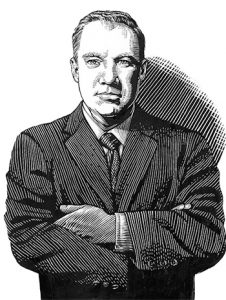
We’ve all heard stories about the janitor who makes his or her way to the top echelons of a major corporation.
But what about the janitor’s assistant who, in 1947, met Henry Ford II, president of Ford Motor Co. in Dearborn, and went on to craft a plan to take the automaker public?
Consider the life of Sidney J. Weinberg, who joined Goldman Sachs & Co. in 1907 as an assistant to the janitor. One of his responsibilities was to polish the brass spittoons at the company’s headquarters in New York City.
Weinberg quickly made a name for himself with his hustle and drive, and he caught the attention of Paul J. Sachs, a partner at the time of what today is an American multinational investment bank and financial services company with more than $1.4 trillion in assets.
Sachs’ grandfather, Marcus Goldman, launched the firm in 1869 in a single-room basement office adorned with a coal chute. Goldman’s son-in-law, Samuel Sachs (Paul’s father), came on board in 1882.
As Paul Sachs opened doors for Weinberg, the young apprentice was quickly noticed and rose through the ranks of Goldman Sachs, becoming a senior partner in 1930. After meeting Ford II, the two became friends and, in 1956, Weinberg put together
the automaker’s first public offering.
At $657.9 million ($7.3 billion today) and 10.2 million shares, the Ford IPO, led by Goldman Sachs, was the largest common stock offering of its day. Soon after, Weinberg became one of Ford’s first outside directors.
The lasting friendship between Weinberg and Ford II continues to add dividends today. Goldman Sachs first opened an office in Detroit in 1946, where
it advised corporations and multifaceted family businesses. Although the office was closed in 1990, the company maintained strong ties to Detroit and the region.
Last September, that all changed when Goldman Sachs, recognizing the vast amount of wealth that has been built up here — the region is home to 18 Fortune 100 corporations — opened a private wealth management office in downtown Detroit. It’s the only office of its kind in the Midwest outside of Goldman Sachs’ office in Chicago.
Brian Grzelakowski, who serves as the Midwest head of the firm’s private wealth management and institutional client solutions practice, says the region’s growing wealth played a role in the firm’s return to Detroit. But he also was struck by the city’s
startup spirit.
After launching a program called 10,000 Small Businesses in 2010 — it’s a $500 million initiative of Goldman Sachs and the Goldman Sachs Foundation in the United States, the United Kingdom, and France — Detroit soon appeared on the radar.
Fast-forward to today, and the program has served more than 790 small business owners in Detroit through a partnership with Wayne State University. These small business owners represent nearly $883 million in collective revenue and employ 11,700 people.
“The city has a very vibrant startup community that spans fintech, health care, consumer products, and more, and that helps serve as a very attractive and compelling story for the types of clients we work with,” Grzelakowski says. “Detroit is an example in the Midwest where the revitalization has gone very well, and we’re excited to be a part of it.”
In the same way Detroit embraces its entrepreneurial roots, Weinberg never lost his passion for business. To be sure, in his office he proudly displayed one of the spittoons he polished as an assistant to the janitor — a humble reminder that the
true gold standard in life is to add value to others.











